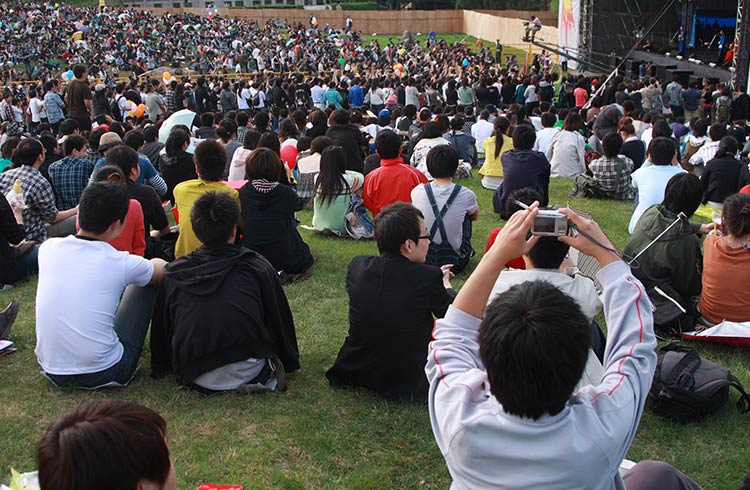The People’s Republic of Rock: Underground Music in China
Marco Ferrarese traces the movement of yao gun (Chinese rock), from its birth to the state of the underground music scene on the streets of China today.
 Photo © Getty Images/bo1982
Photo © Getty Images/bo1982
It’s 2008, just a few months shy of Beijing’s first triumphal Olympics. Wang’s tiny apartment is dimly lit, slightly bigger than a car’s backseat, and tastes of spent cigarettes and dirty rock and roll. “Drink,” he says in Chinglish, passing a bottle of Tsing Tao beer across the floor between us.
Wang has improbable blond hair, dyed and spiked with hand soap, and sings in a Beijing Oi! band, a sub-genre of punk born from working-class, anti-racist skinheads in late 1970s England. I’m the “foreign expert”, aka a teacher of languages, who landed in a second-tier Chinese university 186mi (300km) east of Beijing, one of the world’s busiest cities. With a poor common language, Wang and I connect by referencing the shared global codes of the punk rock music we both love.
- The Birth of Chinese Popular Music
- The Rise and Fall of Chinese Punk Rock
- International Recognition of Chinese Heavy Metal Music
- Chinese Rock Music Today
- Where to Experience Live Rock Music Across China
The Birth of Chinese Popular Music
As China opened up to the world in the late 1970s, it also started forming an acquired taste for Western music and ideas the country had never seen before.
From Jimi Hendrix to The Beatles, the Pet Shop Boys to punk rock: a tsunami of 50 years of foreign popular music history in the form of pirated tapes — coupled with the first influx of language teachers, foreign students, and tourists — washed over the Chinese capital all at once, creating yao gun, or “Chinese rock”. Walking in many of Beijing's street markets, I can see these rock tapes on sale next to smiling jade buddhas, Confucius statues and tacky fake-brass dragons, looking like improbable crumbs of globalization that spilled between the cracks of China's ancient civilization.
Two artists are considered the genre's initiators: Cui Jian, a trained classical musician who fell for the smuggled sounds of The Beatles, The Rolling Stones and Talking Heads. He shot to stardom in 1986, with the song Nothing to My Name, which mixed elements of classical Chinese music with Western electric guitars, which became the unofficial anthem of Tiananmen Square’s student protests in 1989.
The second is He Yong, whose 1994 pivotal album Garbage Dump, filled with nihilistic social commentary, paved the way to the birth of Chinese punk.
In the late 1980s, China also spawned its first heavy metal band with Socialist characteristics, Tang Dynasty, who released its debut album A Dream Return to Tang Dynasty in 1992. Combining progressive rock with heavy riffs, Chinese folk styles and Beijing opera techniques, it went on to sell more than two million copies in Asia and abroad.
I find all these tapes on Beijing's laneways, buy them for a few yuan each, and bring them back to my room in the university. To my Western-trained ears, they sound angry and exotic, harsh and incredibly attractive. My teenage students, of course, don't know anything about them. When I ask my block's caretaker if he has ever heard of Tang Dynasty, he answers that they ruled over China for three centuries until year 907 DC.
Beijing’s Burning: The Rise and Fall of Chinese Punk Rock
From 1995, the seeds of yao gun blossomed into two very antithetic punk bands: Underbaby which used punk’s stereotypical three raw chords, safety pins, and mohawks, and Catcher in the Rye with its melodic pop-punk songs. In a couple of years, Beijing’s first punk underground makes a permanent base at the Scream Club, where some of China’s pioneer punk bands like Brain Failure, 69, Reflector, and Anarchy Boys emerged. Their music is collected in a compilation album released on Jing Wen Records in 1997, the first official Chinese punk record.
By 1998, Beijing was considered the center of cultural and musical freedom, attracting musicians, fans and students from all over China.
But soon enough the bars overflowed with too many competing bands, pushing some of Beijing’s early punks to move to the musically untouched southwestern province of Yunnan, thus “exporting” punk rock to the tourist towns of Dali and Lijiang.
Something started changing by the early 2000s, when new foreign trends like nu-metal contributed to making Beijing's music scene more commercial. On top of that, its prime spot as China’s “music city” was overshadowed by the rise of new talented musicians, clubs, and music styles in other cities including Shanghai, Wuhan, Qingdao, Nanjing and Tianjin.
Back in the capital, the years in the run-up to the 2008 Olympics saw the birth of ‘No Beijing’, a new wave of influential and savvy Chinese bands that hint at ‘70s New York’s No Wave art movement. This is when I arrived in China to teach Italian in the coastal town of Qinhuangdao, not far from Beijing. Even if it's busy and polluted, it becomes my weekend escape to sweat off my small-town work frustrations by checking out the 'No Beijing' music scene. The epicenter is the small D-22 bar in the student district of Wudaokou, the main live venue for groups like Joyside, Hedgehog, Carsick Cars, Snapline and the Gar. They mixed post-punk, noise and indie influences, helping widen the appeal of Chinese rock.
When I see Joyside for the first time, the D-22 is packed to the gills with a swarm of teenagers and students in tight jeans and striped t-shirts. As the band rocks into the first song, the crowd surges to the stage, melting into a human monster of twirling limbs, becoming one with the musicians. Sweat and beer condenses with breath, we all feel the punk rocking us down through our solar plexuses, and soon enough my glasses fog, my ribcage feels foreign elbows and knees, and we all become as one with that throbbing, liberating soundwave.
Chinese Heavy Metal Music and its International Recognition
Meanwhile, even Chinese metal rose to fame: from Tang Dynasty’s early prog in the 1990s, which I unfortunately never had a chance to see live, the genre expanded to thrash and death metal with bands like Tomahawk and Overload. By the end of the decade, Yaksa, the first Chinese nu-metal band, and thrash death band, Suffocated, also started making noise. Their crowning achievement was participating in Germany’s Wacken Open Air Festival in 2012, bringing Chinese metal to one of the world’s most important heavy metal stages.
Chinese metal music continued to evolve, the first American and European metal bands started coming to play in China, and the genre also fused with rap and even Mongolian folk — think of successful bands like Hanggai, Nine Treasures and Tengger Cavalry.

Chinese Rock Music Today
The rebelliousness of Chinese yao gun and punk tames with the rise of the Midi Music Festival. Started in 1999 by the Beijing Midi School of Music, the first jazz and rock school in China, the Midi grows to become the biggest music festival in the Republic, changing the face of underground Chinese rock forever. This success kickstarts many other events, including the popular Strawberry Music Festival launched by label Modern Sky, one of China's biggest, and home to 100-odd bands.
When I stop again in Beijing in April 2016, I can't help but notice the big changes in Chinese rock from that sweat-thronged, first burning D-22 performance I experienced almost a decade before. The Strawberry Music Festival will take place a week later over the May Day weekend, with events in both Beijing and Shanghai. Bands no longer play in a packed rickety student bar, but instead perform on the megastage of the Shanghai World Expo Park in front of thousands of people. These massive commercial operations increasingly switched focus from rock to other genres: in 2017 alone, China hosted a staggering 269 music festivals, 20 per cent of which were dedicated to electronic dance music.
Rock bands still take on the stages of China’s major cities, but on the contrary of yao gun, modern rock in China has turned from flash-in-the-pan revolution to middle-class entertainment. Often times populated and maneuvered by expat foreigners, rock music still doesn’t bode well with an ever-conservative Chinese societal mindset. However, almost 40 years of Chinese yao gun have certainly left a mark on China’s popular culture, but that primeval Beijing underground fire, I’m afraid, has already turned to embers.
Where to Experience Live Rock Music Across China
Every major Chinese city has a bunch of music clubs you can visit to check the pulse of the local scene. Here are just a few of the most established:
Beijing
Yugong Yishan
3-2 Zhangzizhong Lu, Miyun County
Beijing’s full-fledged rock club hosts many international acts and yet always keeps an eye on the best from the local underground.
School Live Bar
53 Wudaoying Hutong, Chaoyang
The capital’s current spot for punk, metal and rock is this little scruffy bar packed to the gills with alternatives who always want to have a good, loud time.
Shanghai
Yuyintang
851 Kaixuan Lu
For the past decade, this club has brought the best of rock, folk, metal and more to this vibrant metropolis.
MAO Livehouse
308 Chongqing Nan Lu
Good sized downtown venue catering to international and local acts, from electronica to disco, metal and rock.
Wuhan
Vox Livehouse
118 Lumo Road, Guang Gu Shang Quan, Hongshan Qu Wuhan Shi
The home to Wuhan’s alternative music and punk, this landmark venue sees Chinese and international bands performing here almost every night.
Dali
Bad Monkey Bar
59 Renmin Lu, Dali Old Town
Owned by two Englishmen, this Yunnanese live music bar has been rocking hard since 2003. Also check out its quirky sibling Bad Monkey Steampunk Bar, with music every night, paired with Napoli-style pizzas and burgers.
Simple and flexible travel insurance
You can buy at home or while traveling, and claim online from anywhere in the world. With 150+ adventure activities covered and 24/7 emergency assistance.
Get a quote
No Comments